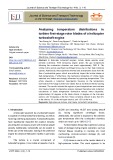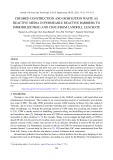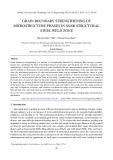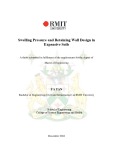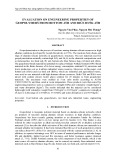
Evaluation on engineering properties
-
This article presents a numerical investigation focusing on the temperature distribution of first-stage turbine rotor blades that do not feature internal cooling channels. The results indicate the regions of peak temperatures and evaluate rotor blade strength.
 10p
10p  viengfa
viengfa
 28-10-2024
28-10-2024
 2
2
 2
2
 Download
Download
-
This study evaluates the effectiveness of using crushed construction and demolition waste as reactive media for applying in Permeable Reactive Barriers to treat contaminated groundwater by landfill leachate. Modern analytical methods such as SEM and EDX were used to analyze the physicochemical properties of crushed demolition waste, demonstrating that the material has a porous structure on the surface that is suitable for the targeted heavy metal adsorption.
 9p
9p  vifaye
vifaye
 20-09-2024
20-09-2024
 3
3
 1
1
 Download
Download
-
In this study, a methodology was created to evaluate the values of the yield stress of materials based on the grain boundary strengthening equation. This method was constructed by observing the average grain size and determining the mechanical properties of three microstructural phases in the weld zone (i.e. based metal, heat-affected zone, and weld metal).
 15p
15p  vifaye
vifaye
 20-09-2024
20-09-2024
 1
1
 1
1
 Download
Download
-
A retaining wall constructed on expansive soil can be subjected to lateral swelling pressures due to soil swelling, which may cause a significant horizontal deformation and bending of the retaining wall. In Australia, it is generally assumed that the backfill behind a retaining wall is non-expansive material. Therefore lateral swelling pressures induced by expansive soils are ignored in routine design.
 115p
115p  runthenight07
runthenight07
 01-03-2023
01-03-2023
 12
12
 3
3
 Download
Download
-
The sorption capacity index a is proposed as a criterion parameter for assessing the quality of impregnated activated charcoals. It was found that this parameter does not depend on the dynamic conditions during the sorbent test. It was shown that values of the sorption capacity index allow to recommend iodine sorbents for industrial gas cleaning processes.
 5p
5p  minhxaminhyeu3
minhxaminhyeu3
 12-06-2019
12-06-2019
 15
15
 2
2
 Download
Download
-
The reactions form chains and rings of alumino-silicate networks in geopolymeric structures. The raw materials used for geopolymerization normally contain high SiO2 and Al2O3 in the chemical compositions such as meta-kaoline, rice husk ash, fly ash, bottom ash, blast furnace slag, red mud, and others. The geopolymer-based material has potentials to replace Ordinary Portland Cement (OPC)-based materials in the future because of its lower energy consumption, minimal CO2 emissions and lower production cost as it utilizes industrial waste resources.
 8p
8p  quaymax4
quaymax4
 05-09-2018
05-09-2018
 29
29
 1
1
 Download
Download
CHỦ ĐỀ BẠN MUỐN TÌM








